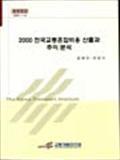Policy Report

RESEARCH
KOTI - Korea Transport institute
(The) Cost of Traffic Congestion in Korea: Estimation and Its Trends in 1990s
- Date
December 31 2001
- Page(s)
page(s)

Traffic congestion is one of the most important factor in transportation field. The traffic congestion in Korea occurs because of an imbalance of traffic demand and supply of facilities. It has a tremendous impact on economy of nation, specifically, increa
1. Introduction 2. Elements and estimate of traffic congestion costs 3. Estimate of 2000 national traffic congestion costs and its trends 4. Improvement of current traffic congestion calculation method 5. Conclusion and further study Bibliography ABSTRAC
1. Introduction 2. Elements and estimate of traffic congestion costs 3. Estimate of 2000 national traffic congestion costs and its trends 4. Improvement of current traffic congestion calculation method 5. Conclusion and further study Bibliography ABSTRAC